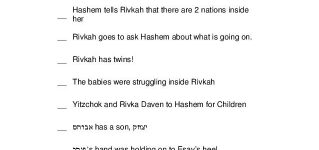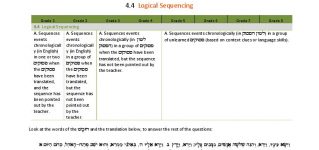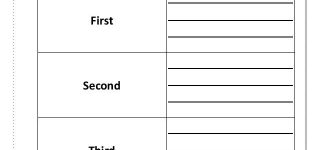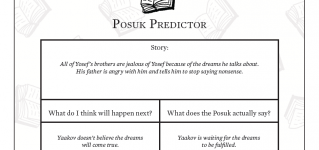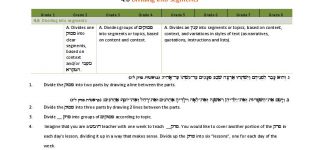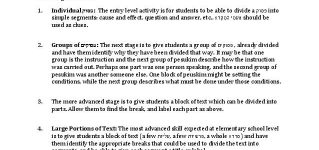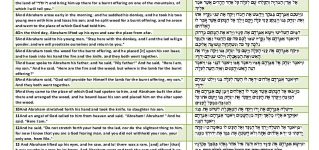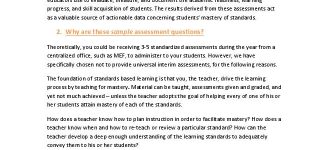Higher Order Thinking
4.03 Logical Sequencing
B. N/A
B. N/A
B. Identifies and sequences cause and effect in a learned פסוק after the cause and effect has been pointed out by the teacher.
B. Identifies and sequences cause and effect in learned פסוקים where the cause and effect has not been pointed out by the teacher.
B. Identifies and sequences cause and effect in unlearned פסוקים (based on context clues, language skills, or key words related to cause and effect[41]).
B. Identifies and sequences cause and effect in unlearned פסוקים (based on context clues, language skills, or key words related to cause and effect[41]).
B. Identifies and sequences cause and effect in unlearned פסוקים (based on context clues, language skills, or key words related to cause and effect[41]).
B. Identifies and sequences cause and effect in unlearned פסוקים (based on context clues, language skills, or key words related to cause and effect[41]).
Grade 2: Sequences events chronologically (in English) in a group of פסוקים when the פסוקים have been translated, but the sequence has not been pointed out by the teacher.
Grades 3-4: Sequences events chronologically (in לשון הפסוק) in a group of פסוקים when the פסוקים have been translated, but the sequence has not been pointed out by the teacher.
Grade 5-8: Sequences events chronologically (in לשון הפסוק) in a group of unlearned פסוקים (based on context clues or language skills).
Grade 3: Identifies and sequences cause and effect in a learned פסוק after the cause and effect has been pointed out by the teacher.
Grade 4: Identifies and sequences cause and effect in learned פסוקים where the cause and effect has not been pointed out by the teacher.
Grade 5-8: Identifies and sequences cause and effect in unlearned פסוקים (based on context clues, language skills, or key words related to cause and effect [41]).
[41] E.g. למען, פן, כי etc.
4.04 Comparing and Contrasting
Grade 1: N/A
Grade 2: Compares and contrasts the actions or experiences of two individuals in a learned story or group of פסוקים, after the comparison was pointed out by the teacher.
Grades 3-4: Compares and contrasts similar personalities, events, and texts in the פסוקים after the פסוקים were translated but the comparison was not pointed out in the פסוקים. (See Appendix for items to compare and contrast, and how to do so.)
Grades 5-6: Compare and contrast similar personalities, events and texts in learned פסוקים to unlearned פסוקים. (See Appendix for items to compare and contrast, and how to do so.)
Grades 7-8: Compare and contrast similar personalities, events and texts in unlearned פסוקים. (See Appendix for items to compare and contrast, and how to do so.)
[42] I.e. “וילכו שניהם יחדיו“ in בראשית כב:ו and again in פסוק ח .
[43] I.e. “פרו ורבו“ in בראשית א:כב. See רש“י there.
4.05 Dividing into Segments, and Finds the Main Idea
B. Retells the content of a learned פסוק in their own words
B. Retells the content of a learned פסוק in their own words
C. Retells the main idea of a story or group of פסוקים after the teacher identifies it.
B. Divides one פסוק into clear segments, and can identify the main idea in the two halves of the same פסוק.
C. Identifies the theme or main idea of a learned story or group of פסוקים from a list of options
D. Divides groups of פסוקים into segments or topics, based on content and context.
E. Summarizes a learned פסוק or group of פסוקים in student’s own words (by distinguishing main ideas from details).
B. Divides one פסוק into clear segments, and can identify the main idea in the two halves of the same פסוק.
C. Identifies the theme or main idea of a learned story or group of פסוקים from a list of options.
D. Divides groups of פסוקים into segments or topics, based on content and context.
E. Summarizes a learned פסוק or group of פסוקים in student’s own words (by distinguishing main ideas from details).
B. Divides one פסוק into clear segments, and can identify the main idea in the two halves of the same פסוק.
C. States the theme or main idea of a learned story or group of פסוקים ,and lists supporting details.
D. Divides an ענין into segments or topics, based on content, context, and variations in styles of text (as narratives, quotations, instructions and lists).
E. Summarizes a learned or unlearned group of פסוקים in student’s own words (by distinguishing main ideas from details).
B. Divides one פסוק into clear segments, and can identify the main idea in the two halves of the same פסוק.
C. States the theme or main idea of a learned story or group of פסוקים ,and lists supporting details
D. Divides an ענין into segments or topics, based on content, context, and variations in styles of text (as narratives, quotations, instructions and lists).
E. Summarizes a learned or unlearned group of פסוקים in student’s own words (by distinguishing main ideas from details).
B. Divides one פסוק into clear segments, and can identify the main idea in the two halves of the same פסוק.
C. States the theme or main idea of a learned story or group of פסוקים ,and lists supporting details.
D. Divides an ענין into segments or topics, based on content, context, and variations in styles of text (as narratives, quotations, instructions and lists).
E. Summarizes a whole ענין (as grouped by פתוחות וסתומות or more in students’ own words (by distinguishing main ideas from details).
B. Divides one פסוק into clear segments, and can identify the main idea in the two halves of the same פסוק.
C. States the theme or main idea of a learned story or group of פסוקים ,and lists supporting details.
D. Divides an ענין into segments or topics, based on content, context, and variations in styles of text (as narratives, quotations, instructions and lists).
E. Summarizes a whole ענין (as grouped by פתוחות וסתומות or more in students’ own words (by distinguishing main ideas from details).
Grade 2-8: Divides one פסוק into clear segments, based on context and/or המקרא טעמי.
Grades 3-8: Divides one פסוק into clear segments, and can identify the main idea in the two halves of the same פסוק.
Grade 2: Retells the main idea of a story or group of פסוקים after the teacher identifies it.
Grades 3-4: Identifies the theme or main idea of a learned story or group of פסוקים from a list of options.
Grades 5-8: States the theme or main idea of a learned story or group of פסוקים ,and lists supporting details
Grades 3-4: Divides groups of פסוקים into segments or topics, based on content and context.
Grades 5-8: Divides an ענין into segments or topics, based on content, context, and variations in styles of text (as narratives, quotations, instructions and lists).
Grade 3-4: Summarizes a learnedפסוק or group of פסוקים in student’s own words (by distinguishing main ideas from details).
Grades 5-6: Summarizes a learned or unlearned group of פסוקים in student’s own words (by distinguishing main ideas from details).
Grades 7-8: Summarizes a whole ענין (as grouped by פתוחות וסתומות) or more in students’ own words (by distinguishing main ideas from details).
4.06 Noticing Anomalies and Deviations
- Repetition of words.[42]
- Repetition of synonyms.[43]
- Repetition of words.[42]
- Repetition of synonyms.[43]
- Repetition of words.[42]
- Repetition of synonyms.[43]
- Missing subject.
- Missing objects.
- Incomplete sentences.
- Missing and extra letters.
- Grammatical inconsistencies.
- Difficulties in the narrative and logical flow of the text.
- Missing subject.
- Missing objects.
- Incomplete sentences.
- Missing and extra letters.
- Grammatical inconsistencies.
- Difficulties in the narrative and logical flow of the text.
- Missing subject.
- Missing objects.
- Incomplete sentences.
- Missing and extra letters.
- Grammatical inconsistencies.
- Difficulties in the narrative and logical flow of the text.
- Missing subject.
- Missing objects.
- Incomplete sentences.
- Missing and extra letters.
- Grammatical inconsistencies.
- Difficulties in the narrative and logical flow of the text.
Grade 1: N/A
Grade 2: Recognizes seemingly extraneous language in the text after it was pointed out by the teacher, such as:
- Repetition of words.[42]
- Repetition of synonyms.[43]
Grades 3-4: Recognizes when facts are missing from the text as well as seemingly extraneous language, such as:
- Repetition of words. [42]
- Repetition of synonyms. [43]
Grades 5-8: Recognizes seemingly extraneous language as well as other anomalies in the text including:
- Missing subject.
- Missing objects.
- Incomplete sentences.
- Missing and extra letters.
- Grammatical inconsistencies.
- Difficulties in the narrative and logical flow of the text.
4.07 Identifying Literal and Contextual Meanings
B. N/A
B. N/A
B. Understands that דברה תורה בלשון בני אדם when encountering anthropomorphic language in learned פסוקים. (e.g. יד ה’, ארדה נא)
B. Understands that דברה תורה בלשון בני אדם when encountering anthropomorphic language in learned פסוקים. (e.g. יד ה’, ארדה נא)
B. Identifies anthropomorphic language when encountered in the פסוקים, and explains that דברה תורה בלשון בני אדם and the significance of the particular analogy being used.
B. Identifies anthropomorphic language when encountered in the פסוקים, and explains that דברה תורה בלשון בני אדם and the significance of the particular analogy being used.
B. Identifies anthropomorphic language when encountered in the פסוקים, and explains that דברה תורה בלשון בני אדם and the significance of the particular analogy being used.
B. Identifies anthropomorphic language when encountered in the פסוקים, and explains that דברה תורה בלשון בני אדם and the significance of the particular analogy being used.
Grades 3-4: Identifies figurative language and explains its meaning after it has been explained by the teacher. (e.g. כחול הים)
Grades 5-8: Identifies figurative language when encountered in פסוקים, and explains the significance of the particular analogy being used.
Grades 3-4: Understands that דברה תורה בלשון בני אדם when encountering anthropomorphic language in learned פסוקים. (e.g. יד ה’, ארדה נא)
Grades 5-8: Identifies anthropomorphic language when encountered in the פסוקים, and explains that דברה תורה בלשון בני אדם and the significance of the particular analogy being used.

